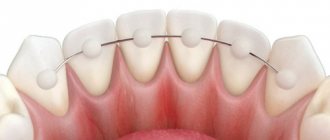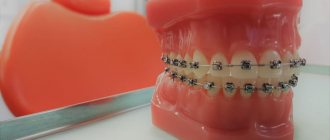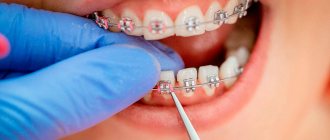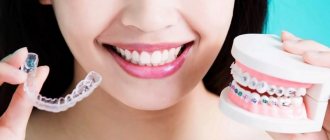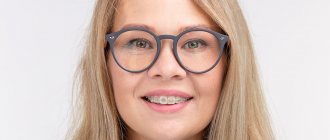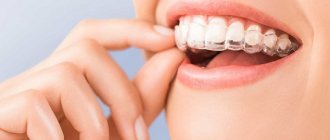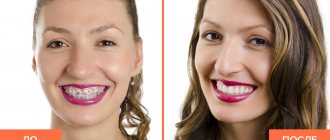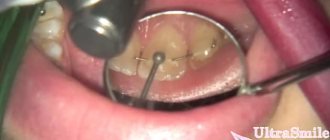Removable structures
Very easy to use, they can be removed independently during meals, hygiene procedures, and if therapeutic dental treatment is necessary. Also easy to install back. There are several types:
- Polymer transparent retainers-aligners, reinforced with a metal arch. They fix the position of the teeth along the length of the jaw and are invisible to others. Used constantly, excluding food intake and care procedures.
- Orthodontic plates consist of a plastic base and fixing metal elements. Basically, the designs are worn at home and put on before bed.
- Positioners keep the teeth in the correct position and restore the tone and density of the gum tissue. Made from elastic polyurethane, they are easy to use and do not cause allergic reactions. Show high effectiveness for minor occlusion disorders.
Removable orthodontic appliances are made within 3-7 days using individual impressions.
The final stage of treatment
Once each tooth has taken its place, therapy cannot be stopped. Indeed, over time, the curvature may develop again, and then all efforts will be useless. It is important to securely fix them in the new position. This is the main purpose of using retention devices. They must be used until the adaptation stage is completed (the period is determined by the doctor). When worn, they are imperceptible and hardly noticeable. It's not difficult to get used to them. Care does not take much time, there is no negative impact on the enamel or gums, and, as practice shows, the result is not long in coming.
Fixed retainers
They are represented by a thin metal arch, which is point-fixed with composite material to the inner surface of each tooth. They are installed immediately after the braces are removed, the adjustment time does not exceed a week. It must be remembered that the results of corrective treatment can only be maintained by constantly wearing retention splints! Neglecting the orthodontist's recommendations leads to deformations of the dentition and bite.
Installation Features
Retainers are installed on the day the braces are removed. Fixation is carried out after polishing the enamel and/or professional hygiene. For better adhesion, a special composition is applied to the surface of the teeth. The installation of removable devices is preceded by taking impressions and making mouth guards, positioners or orthodontic plates in the laboratory.
Instructions for the care and wearing of a removable retention device
- 1. On the first day of wearing a retainer, you may experience slight pain in the area of some teeth. This is a temporary phenomenon that goes away after a few hours.
- 2. In the first days after installing the mouth guard, increased salivation is possible, which goes away after 1-2 days.
- 3. There may be a slight change in diction in the first days after installing the mouth guard. Diction will be fully restored after 2-3 days of regularly wearing the mouth guard.
- 4. If during wearing you notice that the edges of the retainer scratch the mucous membrane of the tongue or cheeks, then in this case you need to contact your doctor to have these sharp edges corrected.
- 5. Under no circumstances should any food be consumed in a removable retainer. This can lead to rapid breakdown of the device.
- 6. You cannot smoke with a mouthguard in your mouth or take coloring liquids (red wine, juices, Coca-Cola, etc.). This may cause the mouthguard to lose its clear properties.
- 7. Do not immerse the mouthguard in hot liquids (more than 40 degrees). This may lead to its deformation.
- 8. In those moments when it is necessary to remove the mouth guard, watch where it is located, because Most often, its loss occurs in cafes, bars and restaurants, during meals.
- 9. When removing the mouthguard, do not put it in your clothing pockets without a special container; if you forget about it, you can easily damage it.
- 10. You need to clean your mouthguard 2 times a day with a toothbrush and soap. You need to be very careful when cleaning. Significant bending of the mouth guard can lead to cracks in it.
- 11. If you have lost your mouth guard, you must urgently make an appointment with a doctor to take impressions and make a new mouth guard. This needs to be done as quickly as possible, because... Without a mouth guard, your teeth can quickly change their position and not for the better.
- 12. If you are far from the clinic, or your doctor is on vacation, other doctors at our clinic, or any dental institution in your place of stay, can take impressions and make plaster models for you.
- 13. The service life of the mouth guard is about 1 year, after which it is necessary to make a new mouth guard. The patient pays for a new mouthguard. In cases where a mouth guard is lost or broken, the patient bears the cost of making a new mouth guard.
PS You may also find it useful to learn how to care for braces.
If you were treated in another clinic, and for some reason you did not have a retention mouthguard installed, and after reading this page you have a desire to maintain the result, then we can make a retention mouthguard for you.
General care recommendations
The retention period is the most important and integral part of the technology for correcting occlusion. The success of treatment largely depends on the patient’s conscientious adherence to the doctor’s recommendations.
- Before fixing them on the teeth, removable retainers are rinsed with a soapy solution; in the morning and before bed, it is recommended to clean them with a special brush with a low-abrasive paste. Once or twice a week, removable structures are soaked in an antibacterial solution. To protect against damage and deformation, tires should be stored in a lockable case.
- Oral care with permanently installed retainers is carried out using traditional methods. For thorough cleaning of mineralized plaque and food debris, threads, brushes, and irrigators are used.
- An indispensable condition for oral health is visiting the orthodontist at least twice a year. An emergency visit to the dentist is necessary in case of discomfort and pain, as well as in case of damage to the aligners, plates or breakage of the metal arch.
Instructions for the care and monitoring of a fixed retention device
- 1. Monitor the integrity of the permanent retainer; periodically check it with your finger in front of a mirror with good lighting. If you feel the retainer moving around any of your teeth, this is a reason to visit your orthodontist. By examining the condition of the retainer in the mirror, you can independently determine the absence of material on one of the teeth, which also requires a slight correction by your doctor.
- 2. In a situation where a non-removable retainer has completely peeled off from all teeth, this is critical and requires an urgent visit to the doctor. If a non-removable retainer comes off completely, it is mandatory to wear a removable retention mouth guard around the clock until you visit a doctor and install the retainer in its original location.
- 3. In no case should you use a toothpick or other objects to pick out food debris from under the retainer; it is more advisable to use a toothbrush.
- 4. Approximately once every 6 months it is necessary to have professional teeth cleaning (if ultrasound is used during cleaning, it is very important that the doctor has sufficient experience working with orthodontic patients). Incorrect operation of the ultrasonic tip in the retainer area can lead to damage to its integrity.
Advantages of the Alfa-Vid clinic
The Alfa-Vid Dental Center invites patients in need of bite correction to a free consultation. At the initial appointment, the doctor will carefully examine the oral cavity and, depending on the clinical case, will offer the best option for retention treatment. We guarantee:
- compliance with international quality and safety standards;
- individual approach;
- comprehensive problem solving.
If necessary, the patient has access to emergency assistance from doctors of related dental specialties (therapist, surgeon, etc.). The clinic is equipped with advanced European-level equipment, and dentists use high-quality materials in their work.
Features of the retention period
Duration. The period of use of retention devices is determined by the treating orthodontist. The more the dental system has been changed, the longer it will be. Additionally, it is influenced by the state of the dental system, the speed of adaptation of its tissues to the new position of the teeth, and other features. The retention period can last as long as the main phase of treatment, or longer.
Daily hygiene. This is done in the same way as when using braces. The constant use of metal plates fixed to the surface of the enamel can increase the risk of its demineralization, accumulation of soft plaque, and the appearance of tartar. To keep your teeth healthy, you need to visit the dentist once every six months for a preventive examination, professional hygiene, and enamel remineralization. These visits are combined with control examinations by an orthodontist, who can adjust the retention apparatus, change recommendations for its use, etc. If a non-removable retainer comes off, causes discomfort, etc., an orthodontist is visited urgently.
Additional treatment. Together with mouthguards or retainers, functional orthodontic devices (regulators, bionators, activators, etc.) can be used at the final stage of treatment. They are installed to finally align the position of the teeth while the adaptation process is underway.
During the retention period, the shape of the dentition no longer changes, and there will be no visible, noticeable results at this stage of treatment. It is important so that the teeth acquire a stable position, and the dental system itself successfully adapts to it.
Dentists at the Dentospas clinic use individually manufactured devices during the retention period, which ensures control over the stability of the teeth. This ensures that the results of orthodontic treatment will not be lost, and the patient’s smile will remain beautiful for a long time.
How much does an orthodontic device cost?
The cost of the structure directly depends on its type, quantity and quality of materials, complexity of manufacturing and installation, and the need for activation in a dental clinic. For example, putting a removable dental plate on a child to expand one row of teeth costs about 14 thousand rubles. Trainers, including selection and training, cost about 20 thousand. Installing a bracket system on one jaw costs at least 40 thousand rubles.
Remember that before treatment you must consult with your orthodontist and choose the best correction option. Because in most cases, one person may need several devices at once within 2-3 years. For example, first a plate or trainer, then braces, and after them, definitely retainers.
Sources
- https://anZub.ru/lechenie-prikusa/vidy-ortodonticheskikh-apparatov/
- https://Dentserv.ru/faq/semnye-ortodonticheskie-apparaty
- https://shifa-msk.ru/articles/ortodonticheskie-plastinki/
- https://MikDent.ru/ortodont/viravnivanie/klassifikaciya-ortodonticheskih-apparatov.html
- https://spacream.ru/stomatologiya/klassifikacziya-ortodonticheskih-konstrukczij-apparaty-mehanicheskogo-funkczionalnogo-i-kombinirovannogo-dejstviya-s-foto
- https://www.mitino-center.ru/uslugi/prikus/lechenie-s-primeneniem-funktsionalnogo-apparata/
- https://orto-info.ru/sistemyi-vyiravnivaniya-zubov/lechebno-profilakticheskie-apparatyi/progressivnyiy-sposob.html
Design overview
Preventive orthodontic devices are standard designs, manufactured in a factory or individually in accordance with jaw models.
Vestibular shields
Experts also call such devices Schonherr's vestibular plate. The product is available in three sizes, taking into account the width and length of both dental arches.
Used to correct open bites caused by prolonged sucking of fingers, pens, pencils and other objects. Also effective in mouth breathing and distal occlusion, which is characterized by protrusion of the upper front teeth and narrowing of the upper row.
After replacing the temporary units with permanent teeth, the anomaly that occurs due to a bad habit can be eliminated. In this case, the vestibular shields work to normalize muscle functions and prevent the ability to bite the lip and suck fingers.
The device includes:
- Thyroid product (located in the vestibule of the oral cavity and completely repeats its anatomical structure);
- Ringlocated on the vestibular side of the shield (circularly trains the muscle structures of the mouth);
- Lingual plastic covering (lingual bell) prevents bad habits;
This is interesting: Prices for lingual braces - how much does it cost to install internal braces in dentistry
Experts do not recommend using a standard type Schonherr plate in the presence of the following disorders:
- significant overlap of the lower anterior elements with the upper incisors;
- prognathic occlusion of the hereditary form.
Also, installation of the device is contraindicated in children who have the habit of putting their tongue in the space between the teeth.
Equilibrator
The main task of the device is to stimulate the development and growth of short lips, as well as increase the tone of the circular muscles of the oral cavity.
The device includes:
- plane (the patient covers it with his lips);
- rods;
- tubes that perform the functions of attachments and are available in various color variations.
During treatment with the device, the strength of the load can be adjusted individually. This is possible due to the collapsible design. The force of impact is reduced or, conversely, increased by the number of weights.
The device is more often used in practical orthodontics to correct short lips and restore the ability to fully close them.
Pinwheel
The device develops and trains the respiratory muscles and the circular muscle structure of the oral cavity.
Structure composition:
- a handle having an axis;
- impeller (wraps the handle).
All elements come into action under the force of the air released when the child exhales.
The reason for use is non-closure of lips caused by impaired nasal breathing.
Jaw expander
The device is a spring product that helps to effectively train facial and chewing muscles.
The action of the structure is similar to the action of the Limberg apparatus, in which extraoral rods soldered to the oral trays are brought closer together due to the contraction of rubber rings, thereby promoting the separation of the jaws.
Four replaceable expander springs have several compression forces:
- 0.4 kg/cm;
- 0.7 kg/cm;
- 1.2 kg/cm;
- 1.8 kg/cm.
In addition, the design includes two types of attachments that can be changed, handles and elastic inserts that block damage to the elements of the dentition.
Spatula horn
In clinical practice, it is used to prevent and correct the unnatural position of individual elements of a row.
The system includes:
- pens;
- two bite plates made in the shape of a semicircle.
The radius of the platforms corresponds to the size of the radius of the anterior section of the dentofacial arches. This allows the structure to fit tightly to the surface layer of the teeth.
To be able to use the device on both jaws during the manufacturing process, the bite pad is positioned at an angle to the handle.
Due to the fact that the working part has a narrow plate for incorrectly located elements and a wide one for supports, the latter are not subject to movement.
The basis for using the device is the arrangement of the teeth in which they are oriented closer to the oral cavity. It is very important that there is enough free space in the jaw arch.
Bite strips and ring
These orthodontic products are used on an individual basis. Their action is based on stimulating the development of masticatory muscles and eliminating dental anomalies, consisting of vertical violations of occlusion.
The rings also effectively stimulate the process of teething in infants and young children. Strips are more often used during adolescence.
Dass Activator
An orthodontic device is a wire element that, during treatment or prevention, trains the circular muscles of the mouth.
A wire with a maximum diameter of 2 mm is twisted into a loop with a rim in the middle. The end parts of the metal orthodontic thread are bent in the form of a triangle in a binary relationship to the rim. The platforms are formed from plastic on ready-made triangles.
The algorithm for using and operating the device is as follows:
- placing the device plate between the lips;
- inserting the thumb into the rim and holding the device;
- compression of the lips, leading to the convergence of the plates;
- opening the lips under the elastic force of the wire element.
Rogers Activator
The device develops lip strength and muscles in the corners of the mouth.
The design includes:
- handle;
- replaceable springs (two pcs.);
- mouthpieces;
- nozzles
Rudolph's loop plate
The product has the form of a plate device equipped with protrusions in the form of a wire grid.
Orthodontists use the product for:
- eliminating bad habits associated with incorrect tongue placement;
- elimination of the infantile type of swallowing, in which food is directed into the oropharynx by the tongue located between the dentition.
Fixed orthodontic equipment
1. Braces systems
- Self-ligating metal brace system Damon Q
is an external non-ligating brace system from one of the leaders in the production of braces - Ormco (USA). In self-ligating brace systems, the arch is attached to the bracket not with a ligature - a special wire or rubber band, but with a lock that is located on the bracket. The arch slides freely in the bracket groove, so the orthodontic forces in such a bracket system are very small and physiological. Compared to the classic ligature bracket system, the Damon Q self-ligating bracket system is faster. The patient will come to the orthodontist less often with her. The dimensions of the Damon Q braces themselves are reduced, so the metal bracket system looks very aesthetically pleasing. Due to the low physiological forces, such braces can be used in the treatment of patients with periodontal pathologies. Damon Q braces are suitable for patients of any age. In our opinion, this is one of the best, reliable and comfortable braces systems at an affordable price.
- Self-ligating ceramic bracket system Damon Clear | Clear 2 is
an aesthetic, invisible bracket system and its newer modification from the Damon family, from Ormco (USA). Damon Clear is often called sapphire braces because their ceramic has unique properties and resembles sapphire. It is completely invisible on the teeth, does not stain or change color during treatment. At the same time, the bracket system has all the advantages of self-ligation - it creates low forces on the teeth, and the speed of treatment with it is higher than with a conventional one. With it, the patient spends less time in the orthodontist’s chair and visits the clinic less often. Damon Clear is suitable for orthodontic treatment of patients of all ages.
- The MINI Diamond ligature metal bracket system is
a very reliable classic ligature bracket system with a reduced bracket size from our favorite manufacturer - Ormco (USA). Due to its practicality and aesthetics, the MINI Diamond brace system has become the favorite brace system of teenagers all over the world. And its elastic ligatures, which hold the orthodontic arch, are a stylish and bright accessory that lifts your spirits. This is one of the thinnest and most comfortable braces to wear. Moreover, its price is more than affordable. Ideal for treating children and adolescents.
- Ligature sapphire bracket system Clarity is
an aesthetic bracket system from 3M Unitec (USA). Sapphire braces are made from single crystals of artificial sapphire. Such braces completely “dissolve” on the teeth, due to the fact that artificial sapphire has the refractive index of saliva light. The Clarity sapphire bracket system features a comfortable, smooth lock, the base of which adheres well to the surface of the tooth. But at the same time, it does not create problems during removal, like many of its sapphire counterparts. Used to treat mainly adult patients.
- Incognito lingual brace system is
internal, i.e. A bracket system installed on the inner - lingual surface of the tooth. It is made from an alloy with a high gold content. Lingual braces "Incognito" are completely invisible to others, because... located BEHIND the teeth. At the same time, due to the low, comfortable profile of the locks, the patient experiences virtually no problems with diction and eating during treatment. The Incognito bracket system is produced individually based on computer modeling of treatment based on a 3D model of the patient’s jaws. Braces and a set of arches for them are manufactured “for each patient” fully automatically, which eliminates the human factor. This technology gives a lot of advantages to the doctor when planning treatment, and allows the patient to see the result of treatment with braces even before it begins. Lingual braces are only suitable for adult patients.
- Partial braces
are braces that are not installed on all teeth, but only on individual teeth. Most often, a partial brace system is fixed to the front 4 incisors and the last 2 molars - this configuration is called a “2x4 device”. They are used to treat children aged 8-10 years in mixed dentition. Very effective when there is not enough space for teeth to erupt. We use them on both the lower and upper jaws.
In the partial braces system we use 2 types of braces:
- Self-ligating metal Damon Q,
- Ligature metal MINI Diamond.
2. Additional fixed orthodontic appliances
- The Power Scope device is a standard-issue orthodontic device that is attached to the arches of the bracket system. Used to correct bite in difficult cases. Combines high efficiency, wearing comfort for the patient, convenience and ease of installation. In our clinical practice, he excels in various types of complex tooth movements: correction of midline asymmetry, closing and opening gaps in the dentition. It is installed on the bracket system for a certain period of time, then treatment continues in the standard mode.
- Quad Helix device . In Russian it is pronounced as "kvadhelix". This is a wire palatal structure (buggel) supported on molars for the correction of the upper dentition and expansion of the upper jaw. Sometimes we use it as a preliminary stage before treatment with braces. It is used to treat both adults and children. The device is small in size, unnoticeable when talking and smiling, and gives very good therapy results. The disadvantage of Quadhelix is the need to get used to the design.
- A device for preserving space after tooth extraction - an orthodontic spacer.
Indispensable for early removal of baby teeth, when there is more than a year left before the natural eruption of permanent teeth. To prevent adjacent teeth from shifting to the place of the removed one, the orthodontist puts on a special structure that will preserve space for the future permanent tooth. Such a device is made individually and can have a different design. Sometimes orthodontists can get very creative to ensure that it is effective and comfortable for your baby.
Retention devices
Retention (holding) orthodontic devices are intended to maintain the achieved therapeutic effect until complete morphological and functional restructuring, which is the prevention of relapses. The need for their use is due to the fact that the histological processes of restoration of infinitive bone tissue proceed much more slowly than the morphological and functional restructuring that was achieved during the active period of orthodontic treatment.
Retention devices must hold the tooth or jaw in a new position, minimally limit the basic functions of the oral cavity, be as aesthetic as possible, and not have a forceful effect on the dental system.
The choice of retention device design depends on the child’s discipline, parental supervision of the child, and aesthetic indications.
Retention devices can be removable or non-removable. Removable retention devices are removable plate devices for the upper or lower jaw with a plastic base with or without clasps. If necessary, vestibular arches are added to the design of the retention apparatus (Fig. 56, a). Bioplast dental aligners also give good results.
Non-removable retention devices (Fig. 56, c) are soldered rings, crowns or rings with soldered tangent beams. In some cases, industrially manufactured retainers are used (Fig. 56, b).
Medical plate devices in an inactive state can be used as retention devices. So, M.A. Napadov (1968) recommends leaving orthodontic appliances in the oral cavity as retention devices without further activation after completion of the active period of orthodontic treatment.
After treating malocclusions with an intermaxillary rubber traction, doctors often use the treatment device as a retention device, extending the period of use and weakening the rubber traction. However, a non-removable mouth guard should not be used as a retention device. Long-term use of it contributes to the occurrence of dental caries and the formation of new occlusion anomalies. It is not recommended to use an Angle arc or other arc treatment devices as a retention device, which limit the mobility of individual teeth and worsen the hygienic condition of the oral cavity (unsatisfactory cleaning of interdental spaces).
L.S. Persin (1998) recommends the use of the new OSAMU horseshoe retainer, which covers only the dental arch and part of the apical mucosa, developed by Dr. Osamu Yoshii. The retainer is made by pressing two high-quality transparent plates under pressure: soft bioplast (covering the teeth up to the alveoli) and hard-elastic Imprelon “S” (in the area of chewing surfaces).
According to G.B. Ospanova, E.V. Khazina et al. (1997) recommended the following schemes for wearing the retention apparatus: the first 3-6 months - 24 hours a day, the next 6 months every other night and then once a week. According to the authors, the orthodontist should monitor the patient for 4 years to prevent relapses.
As retention devices, the authors use elastomeric aligners, cast splinting clasps, retainers, adhesive cast structures, bracket systems with finishing arches, composite reinforced retention devices (Fiber Speint, Ribbond, standard lingual multi-link and twisted wire).
5.8. The choice of orthodontic appliance design depending on the patient’s age.
The goal of orthodontic treatment is not only to correct the position of individual teeth or the relationship of the dentition, but also to prevent “persistent correlative morphological and functional transformations based on a conditionally reflexive nature, which, naturally, is most achievable and effective with early intervention” (V. Yu Kurlyandsky).
The question of age-related indications for orthodontic treatment is the main one, since the correct answer to it is of great importance. In this regard, statements on this issue by domestic and foreign authors are of interest. The sooner defects in the teeth and dentition are eliminated, the bite is corrected, the position of the tongue and lips and the function of the oral cavity, chewing and facial muscles are normalized, the easier and faster positive treatment results are achieved in childhood.
According to Yu. B. Ginzburg, the structure of the alveolar process during growth changes under the influence of the chewing function. Before the eruption of primary teeth, the alveolar bone has a coarse fibrous structure; in the presence of temporary teeth, it becomes lamellar; during the change of teeth, osteon systems appear in it; Around the age of 20, the process of bone formation ends. Thus, orthodontic treatment is advisable at a time when the bone structure is less complex and easily amenable to influence.
According to B.N. Bynin, the most favorable period for orthodontic treatment is the period of mixed dentition. The author did not consider it possible to correct anomalies of temporary occlusion with the help of orthodontic equipment. B. N. Bynin emphasizes the inadmissibility of using any kind of mechanical equipment, much less an elastic arc, in such an early period.
Angle believed that the age of 4–6 years is favorable for the treatment of anomalies, since the facial skeleton undergoes changes even during temporary dentition and treatment at this age prepares the way for the development of a correct permanent dentition.
According to Ya.S. Khurgina, during the period of temporary occlusion, the intervention of the orthodontist should be limited to myotherapy, disorientation of the bite by grinding down the cusps, and sometimes only observation. In temporary occlusion, treatment using mechanically operating equipment is contraindicated, and the use of other equipment is ineffective due to the fact that the rudiments of permanent teeth, moved as a result of treatment along with temporary teeth, after a certain period of time (after the loss of temporary teeth) return to their original position and this causes the recurrence of deformities during the period of mixed dentition.
I.L. Zlotnik spoke out as a supporter of early elimination of anomalies. He points out that the number of relapses in the orthodontic clinic has sharply decreased, which was facilitated by the improvement of treatment methods and, to no less extent, the rejuvenation of the age composition of patients. The author recommends starting treatment for children aged 4–7 years. When treating progeny in a temporary dentition, the author advises eliminating bad habits, grinding off the cusps of temporary canines, using crowns that separate the dentition, a chin sling, and myogymnastics.
When progenizing a temporary occlusion, A.Ya. Katz recommends grinding down the cusps of the canines, and sometimes the cutting edges of the lower (temporary) incisors in order to free the lower jaw from the forced progenic state. In case of mixed dentition, the author considers it indicated to strengthen bite-dissociating crowns on the lateral teeth. When the upper teeth tilt inward or the lower teeth outward A.Ya. Katz suggests using guide crowns on the upper central incisors with extensions for the lateral incisors. The author considers it possible to use guide crowns with an inclined plane in temporary dentition. In his opinion, the only contraindication to such treatment during this period is significant mobility of the temporary incisors.
For the treatment of all types of progeny in temporary dentition E.D. Laletina used Katz guide crowns. Long-term results up to 5 years and up to 20 years showed a lasting positive effect. Based on these observations, the author came to the conclusion that correction of false progeny during the period of temporary dentition promotes the correct development of permanent dentition.
MM. Khotimskaya considers it inappropriate to prescribe functional-guiding equipment during the period of temporary occlusion - Katz guide crowns and mouthguards with an inclined plane, the use of which should be considered as a therapeutic measure, meanwhile, according to the author, self-regulation of malocclusion is possible in early childhood.
A.I. Betelman advocates starting treatment for children with malocclusions between the ages of 4 and 7 years. Our own research confirms the benefits and effectiveness of early correction of malocclusions.
V.Yu. Kurlyandsky stated that the question of the age most suitable for orthodontic treatment has not been completely resolved and will remain relevant for a long period of time. The author believed that treatment should begin soon after identifying a dental anomaly, regardless of age. To correct temporary occlusion, the author recommends the elimination of bad habits, grinding off the cusps of the teeth that prevent the correct closure of the dentition, treatment of the nasopharynx, bite separation, the application of extraoral dressings that retard the growth of the jaw bones and myogymnastics.
The point of view on the need for early treatment of children during the period of temporary occlusion finds a large number of supporters.
There is no consensus on this issue among foreign authors. Some authors (Anderson, Beker, ea) recommend orthodontic treatment of young children with temporary dentition, others (Altmann, Nord, ea) prefer to start treatment during the period of changing teeth. Korkhaus, Neumann, Oppengeim, Beichenbach and others offer a differentiated approach, namely, most authors recommend treating early (during the period of temporary dentition) true progenia, crossbite and later - at 8-10 and even 11 years - prognathia and deep bite . Higley and Skaloud attach great importance to myotherapy (special gymnastics), the founder of which should be considered Rodgers (1917). The authors emphasize the importance of proper muscle function for the development of the organs of the dental system. Prevention in infancy and early childhood is given great importance.
Treatment with a function regulator is most effective in the final period of temporary occlusion, the initial period of replacement, since during these periods there is an increase in jaw growth. Normalization of the functions of the dental system, breathing and blood circulation speeds up orthodontic treatment.
The best results of treatment with function regulators are observed at the age of 6 - 8 years. Treatment of distal occlusion with this apparatus is not indicated during the period of physiological resorption of the roots of temporary canines and their replacement. The function regulators rest on the canines, which ensures the stability of the apparatus and the distal movement of these teeth. Increased pressure on temporary canines only accelerates their loosening and loss. In such cases, it is better to use other designs of orthodontic appliances. It is advisable to begin treatment before the eruption of the second permanent molars and to use increased jaw growth in the anterior direction during this period.
The use of function regulators is indicated up to 14 - 15 years of age. However, in some cases it gives positive results even at an older age, which depends on the final timing of ossification of the skeleton.
Depending on the period of bite formation, appropriate designs of function regulators are selected. During the periods of temporary and the beginning of mixed dentition, special regulators are used (for early treatment) with wire parts resting on the occlusal surface of temporary molars. These parts prevent the adjuster from tipping over and maintain the desired bite release. When talking, swallowing, and facial expressions, the device promotes gymnastics of the muscles of the perioral area. Speech therapy exercises are of great importance - loud pronunciation of sounds, when the child is forced to close his lips and, therefore, cover the device with his lower lip.
When treating older children and adolescents with pronounced dental anomalies, preliminary removal of individual teeth is indicated. More often than other teeth, the first premolars or the first permanent molars destroyed by caries are removed.
After correcting the bite with the function regulator, a retention device is not required. The regulator can be used in the future, gradually reducing the time, which ensures the sustainability of the treatment results.
With the correct technical manufacture of the regulator, after a relatively short period of mastering it (within 1 - 11/2 months), facial expression improves. Analysis of lateral teleroentgenograms of the head showed that the regulator can be used to ensure jaw growth, teeth movement, and change in bite height.
Relapses of anomalies are observed in cases where, during the treatment, lip closure was not achieved or the bad habit was not eliminated. Normalization of the functions of the lips, cheeks and tongue is a prerequisite for the sustainability of treatment results.
Control questions:
1. Name the author of the classification of orthodontic appliances?
2. How are orthodontic appliances classified according to their operating principle?
3. How are orthodontic appliances classified according to the method and place of action?
4. How are orthodontic appliances classified by type of support?
5. How are orthodontic appliances classified by location?
6. How are orthodontic appliances classified according to the method of fixation?
7. How are orthodontic appliances classified by type of design?
8. List the main structural elements of orthodontic appliances.
9. What elements of orthodontic appliances are considered fixing?
10. What elements of orthodontic appliances are considered operational?
11. What elements of orthodontic appliances are considered auxiliary?
12. List the operating parts of functional devices.
13. How are wire mechanical elements activated?
14. How are orthodontic screws activated?
15. How long does it take to replace ligatures?
16. What are the phases of adaptation to orthodontic appliances?
17. What are the rules for choosing a support for an orthodontic apparatus?
18. What are the objectives of using retention devices?
19. What are the main designs of retention devices?
20. What are the terms of use of retention devices and the mode of their operation?
21. What are the age indications for the use of orthodontic equipment?
22. What factor determines the indications for the use of fixed orthodontic appliances?
Situational tasks:
1. Child 8 years old. The lower incisors completely overlap the upper ones. The lateral teeth occlude normally. Name the device:
A. Bruckle apparatus
B. Khurgina apparatus
C. Angle's expansive apparatus
D. Removable plate apparatus for the upper jaw with bite pads in the lateral areas.
E. Removable plate apparatus for the upper jaw with a bite platform in the frontal area.
2. Name the combined action device:
A. Kappa Bynina
B. Ainsworth apparatus
C. Bruckle's apparatus
D. Katz apparatus
E. Engle's apparatus
By type of design
Orthodontists have a wide range of devices that help correct bite defects. Among them are:
- Plates. They are used mainly in childhood, when teeth are changing. This allows you to easily influence the bite during its formation and avoid complex orthodontic treatment in the future. They can be removed periodically so as not to force their effect on the fragile maxillofacial apparatus.
- Mouthguards. Removable devices that must be worn at least 2 hours a day. It happens that doctors allow you to remove them only for brushing your teeth and eating.
- Braces. A popular solution for teenagers over 13 years old and young adults. Fixed structures are worn for 1-2 years, they do not interfere with active life, and are considered fashionable. The basis of braces is an arc mechanism that gradually brings the teeth into the correct position.
- Blocks. Used to correct jaw growth. At the same time, the row is aligned and the bite is changed.
It is difficult to accurately answer which orthodontic device will correct the problem better. Much depends on the characteristics of the patient’s dental system, how old he is, and financial readiness. It is better to correct the bite in childhood, but it is not too late at an older age. To do this, you should contact a qualified orthodontist and follow his recommendations.
Classification according to operating principle
The operating principles of the devices are based on traction force
The following principles can be incorporated into the operation of the orthodontic apparatus: mechanical action, functional, combined, retention. Mechanical or active devices contain miniature springs, arcs, screws, ligatures, rods, beams, and rubber rods. All of these can be a source of force, which can be adjusted by the orthodontist.
The operating principle of functional 1 devices is based on the force of contraction of the facial and chewing muscles. The force is redistributed through the structural elements to the causative teeth or jawbone. This restores the functionality of the dental system, nasal breathing, and corrects the position of the tongue in the mouth. The components of functional devices include an inclined plane, a bite block, an occlusal pad, and guide loops. Combined orthodontic structures combine two operating principles – mechanical and functional.
On a note! Retainers or retention devices are needed after the main treatment to maintain the result - so that the teeth do not move into the wrong position and the functioning of the dental system is not disrupted. Typically, retainers are worn 2-3 times longer than treatment devices. But in size they are not so massive and more comfortable.
Functional
A group of orthodontic devices whose elements affect the jaw only during chewing are called functional. The structures are presented in the form of plates located in an inclined plane and exerting pressure on the muscles of the oral cavity, regulating the direction and strength of their contractions, due to which the bite is corrected.
Depending on the method of fixation, functional orthodontic systems are either removable or non-removable. Regardless of the type, they are manufactured individually, taking into account the structural features of the jaw of a particular patient.
Functional guides
Such devices include inclined planes, bite pads, guide loops, and occlusal pads. Their work is carried out due to the functioning of the facial muscles. Their effect is transmitted to the areas being corrected or the lower jaw.
An example of a device is the Bynin mouth guard for changing the location of the anterior dental units. It is a single-jaw device of small or medium hardware impact. Worn around the clock. The exception is eating and brushing your teeth. Bynin's mouth guard is made individually.
Functionally active
The devices allow you to normalize the reflexes of swallowing, chewing, and closing your lips. With their help, the doctor deals with issues of jaw development, abnormal bite deformations, and the formation of an even smile.
Examples are cheek shields, lip pads up to 2.5 mm thick. Labial pelota push one of the lips forward and promote the growth of the apical base. Cheek shields separate the cheeks and teeth, stretch the periosteum, and allow you to correct the shape of the jaw.
This is interesting: Is it possible to get and wear braces during pregnancy?
Functional apparatus: treatment results
When treating with functional devices, the following processes are carried out:
● the growth of the facial part of the skull is corrected in the right direction;
● violations of the jaw relationship are eliminated;
● the dentition is aligned and the gaps between the teeth are closed by changing the position of the dental units.
Duration of treatment with a functional device
Unfortunately, all processes of change in hard structures, which are the jaws and teeth, occur rather slowly. For this reason, treatment with functional devices takes a long time. But at the moment, faster methods simply do not exist. The duration of treatment varies from one to two years and depends primarily on the individual characteristics of the patient’s jaw development.
Mechanical
Mechanical-type devices act on the teeth due to the pressure created by the active force of their components (screws, springs, inclined arches and rubber rods). The patient's chewing muscles remain unused.
Mechanical systems usually require constant wear (this is largely due to the complexity of their design and the high precision required when setting up parts of the device) and are made non-removable. The most widespread of all the devices in the group are braces.
Combined
The operating principles of combined devices are clear from their name. The combined elements of mechanical and functional systems in their design allow these devices to effectively cope with the correction of complex dental pathologies. Sometimes such devices are also called “mixed-action correctors.”
What are orthodontic appliances
Translated from Latin, “orthodontist” means “straight tooth,” and an apparatus is a device consisting of several elements that performs any function or several at once.
Thus, orthodontic appliances are devices for correcting the position of teeth and correcting malocclusion. You can start wearing them from very early childhood - from about 2 years old. Orthodontic appliances are devices for correcting malocclusion
Operating principle
Removable orthodontic appliances gently act on the teeth, allowing them to take the correct position. The devices have versatile actions. By eliminating the defect, the dental structure changes the position of the tongue, so the baby’s speech becomes clearer and breathing normalizes.
Orthodontic dentures are an excellent alternative to braces. They are easy to remove and install by parents. This is a big plus, because the device can be thoroughly cleaned and removed for walks with peers.
Attention! Thanks to the dental device, dental defects in children are eliminated in just 3 months. After all, “young” teeth quickly return to their places. If the treatment takes place in the summer, then your child will meet the long-awaited September 1st with a perfect smile.
Why is retention needed?
- Braces have a mechanical effect on the bone and mucous tissues of the periodontal tissues, and after removing the plates, time is needed for the reorganization of these tissues.
- At the end of the course of wearing braces, the teeth are in an unstable position, pressure from the soft tissue creates a risk of relapse.
- In adolescents, changes associated with tooth growth can also cause some changes in the bite after treatment, so retainers become a necessary measure.
